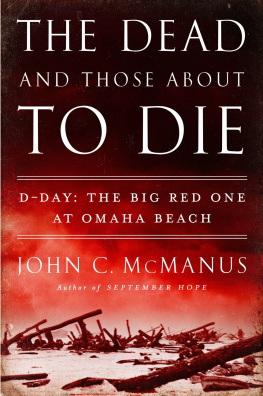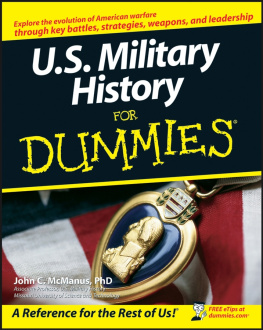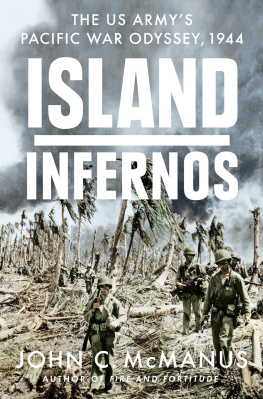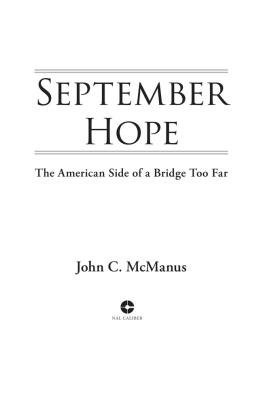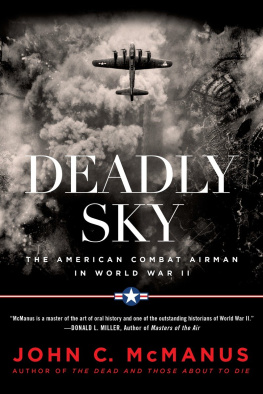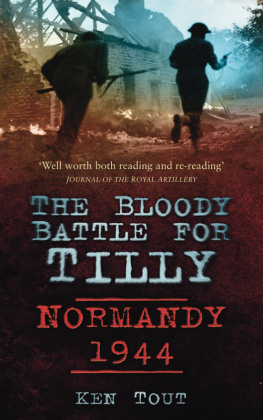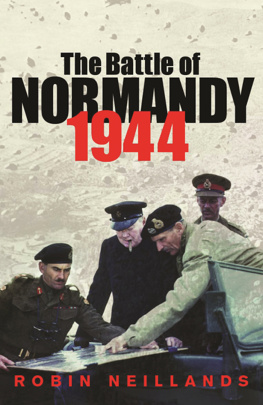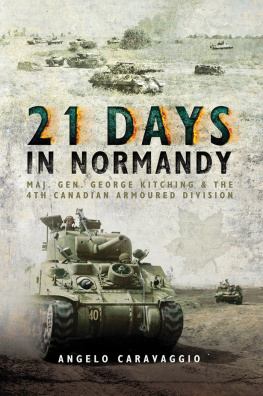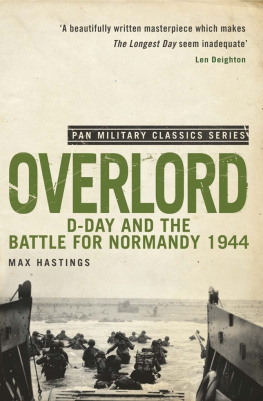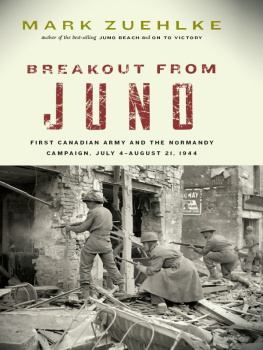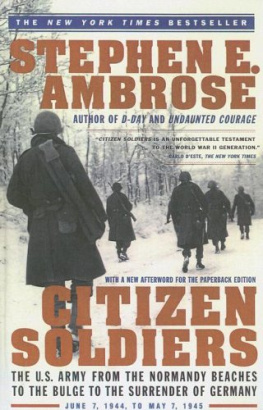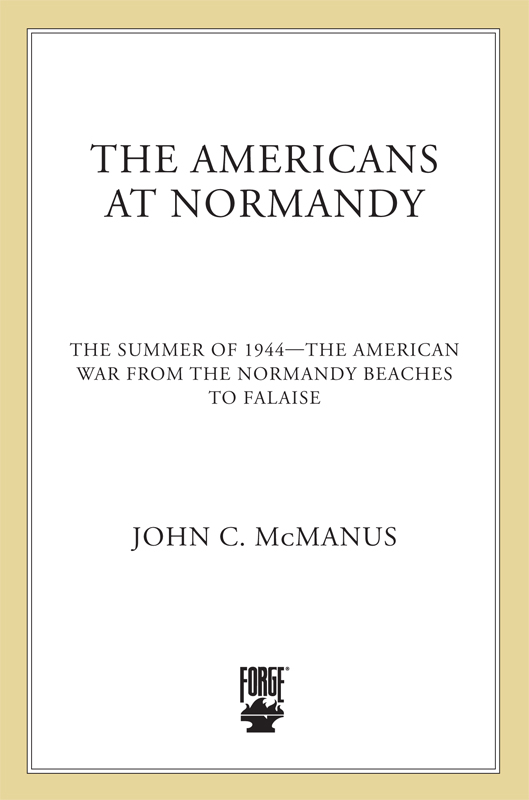
The author and publisher have provided this e-book to you without Digital Rights Management software (DRM) applied so that you can enjoy reading it on your personal devices. This e-book is for your personal use only. You may not print or post this e-book, or make this e-book publicly available in any way. You may not copy, reproduce, or upload this e-book, other than to read it on one of your personal devices.
Copyright infringement is against the law. If you believe the copy of this e-book you are reading infringes on the authors copyright, please notify the publisher at: us.macmillanusa.com/piracy.
CONTENTS
Part I:
Part II:
Part III:
To those 9,387 Americans who lie under crosses and Stars of David at St-Laurent and to their luckier comrades who made it home
LIST OF MAPS
ACKNOWLEDGMENTS
This book, like its antecedent, The Americans at D-Day, would not have happened without the efforts of many good people, most of whom I thanked in the acknowledgments to that volume, but they deserve mention again. Doug Brinkley and his staff at the Eisenhower Center in New Orleans greatly expedited my use of their remarkable collection of World War II oral histories. This archive is among the very best sources of firsthand accounts from American veterans of that war. At the University of Illinois archives, Ellen Swain helped me navigate through an extensive collection of documentary material from the 3rd Armored Division. Ronald Marcello and Christopher Koontz at the University of North Texas were kind enough to send me transcripts of several interviews with Normandy veterans. Jay Graybeal at the United States Army Military History Institute helped find many good photographs that added much to this book.
The University of MissouriRolla interlibrary loan department ordered hundreds of books and articles for me. Scott Peterson and several other members of the library staff often went out of their way to find rare material. Without their efforts, this book would not have been possible.
The History Department at UMR provided me with financial support for my travels. I would like to thank, once again, my colleagues in the department for their advice, support, and friendship. Wayne Bledsoe, Jack Ridley, Tseggai Isaac, Lance Williams, Pat Huber, Jeff Schramm, Michael Meagher, Harry Eisenman, Diana Ahmad, and Larry Gragg all contributed perspectives on a range of issues. Special thanks go to my mentor, Russ Buhite, for his support and guidance. Larry and Russ read and commented on various portions of the manuscript, and I appreciate their time and expertise. Thanks also to Tom Fleming for being a daily inspiration.
My editors at Forge deserve my gratitude for their professionalism and good cheer. Before moving on to the Czech Republic, Brian Callaghan handled many of the onerous tasks of manuscript format, copying, and preproduction. Eric Raab came aboard in the middle of the project and promptly did a fantastic job at all of the above. Thanks for everything, Eric. Bob Gleason, executive editor at Forge, first came up with the idea of splitting my Normandy research into two volumes, and I believe this was fortunate. It reflects Bobs sage wisdom and his knowledge of the publishing world and history in general. Much appreciation goes to Ted Chichak, my literary agent for his counsel, advice, and sapience. Thanks, Ted. The excellent work of fellow Normandy authors such as Mark Bando, Stephen Ambrose, John Keegan, Max Hastings, Aaron Elson, George Koskimaki, Joseph Balkoski, Martin Blumenson, Mark Reardon, Glover Johns, James Carafano, Carlo DEste, Robin Neillands, and a slew of others has added much to this book.
Friends and family have, knowingly or not, made special contributions. Ed Laughlin, a close friend who is a veteran of the 82nd Airborne Division, provided me with much good information on his divisions experiences in Normandy. Many thanks to Mark Williams, Sean Roarty, Bob Kaemmerlen, Joe Carcagno, John Fowler, Mike Chopp, John Villier, Steve Kutheis, Ron Kurtz, and Dave Cohenall good friends and good people.
My family deserves enormous appreciation. My in-laws, Ruth and Nelson Woody, Nancy and Charlie Swartwout, Doug, David, Angee, Tonya, and the kids are all very special people. My brother, Mike, is a fellow military history enthusiast (and a pretty darned good hockey linemate) who is often willing to tolerate my long discourses on my research. With such influences, its almost inevitable that his son, little Mikey, will grow up to study military history. My sister, Nancy, her husband, John, and my nieces, Kelly and Erin, are awesome in every way. Michael and Mary Jane McManus, my parents, to whom I dedicated the preceding volume, merit all the appreciation I can possibly give them. They have done more for me than I can ever repay. As always, my wife, Nancy, deserves the most thanks. She found most of the photos in this book and is the embodiment of a loving wife and partner. Without her, Id be nowhere. As with The Americans at D-Day, this book is hers as much as it is mine, although any errors are my sole responsibility.
My final word of appreciation goes to the Allied veterans of the Battle of Normandy. Long ago, in your youth, you laid your lives on the line, destroyed a monstrous tyranny, and bequeathed to successive generations the great gift of freedom. It is a gift we must still appreciate and fight for in the twenty-first century.
J OHN C. M C M ANUS
St. Louis, Missouri
April 21, 2004
PREFACE
In the summer of 1944, the United States became a superpower and, in so doing, assumed leadership of the Allied war effort. On a diverse set of battlefields that spanned the globeplaces as distant from one another as the Mariana Island chain, Italy, and Francethat leadership came to fruition, but nowhere more significantly than at Normandy. The western Allied invasion of Normandy had not, as German Field Marshal Erwin Rommel hoped, been repulsed at the waters edge. But the success of the invasion in no way secured an eventual triumph for the Allies. Nonetheless, historians, in studying the Battle of Normandy, have largely concentrated on the invasion, as if merely getting ashore on D-Day somehow guaranteed victory for the Allies. In so doing, many historians have, at least implicitly, accepted Rommels thesis that the battle would be decided on the day of the invasion. Rommel felt that Germanys only hope was to repel the Allies at the waters edge. If the Germans failed to do so, then the overwhelming might of Allied logistical superiority would inevitably defeat them. From this assumption came the viewpoint, espoused by some historians, that the U.S. Army fought badly at Normandy. In their view, American soldiers were outmatched in valor and expertise by the Germans, and the Yanks only won because of the sheer weight of numbers or matriel.
These assertions are incorrect. Not only was Rommel wrong in his strategy to crush the invasion at the waters edge (his elaborate defenses held off the Allies for, at best, half a day), but the contention that American soldiers did not fight well is deeply flawed. The reality, as this book will show, was quite different. The United States Army came of age at Normandy. It became a tough, battle-hardened, thinking army whose soldiers routinely fought with great bravery. This does not mean that American leaders and soldiers did not make mistakes. Of course they did, but they generally learned from them.
In the first volume of this series, I covered the American contribution to Operation Overlord. This book picks up where that one left off. Thus, The Americans at Normandy deals with the weeks after June 6, 1944, when the future of Europe was decided. The essence of compelling history is, I believe, the story of individuals who are shaped, defined, and affected by the events of their times. At Normandy, in the summer of 1944, at a key moment in the worlds history, individual Americans, from the lowliest private to the grandest general, sacrificed and helped produce victory. This book will reflect their perspective. More than anything, I hope to convey, through new viewpoints, the American experience in, and the vital American contribution to, the outcome of one of the worlds most important battles. In the end, only the reader can decide if I have succeeded.


